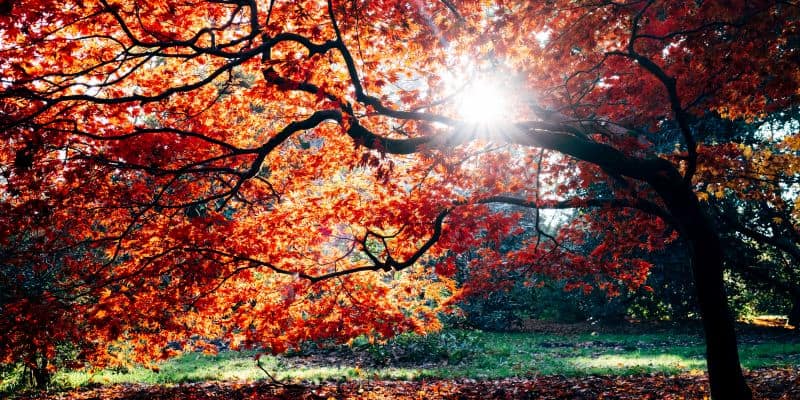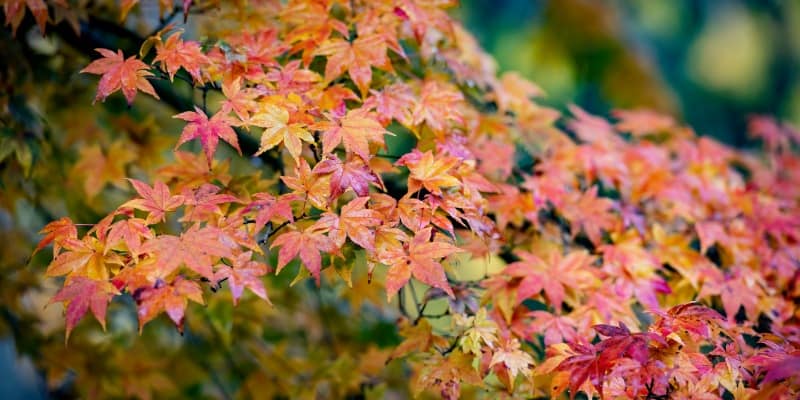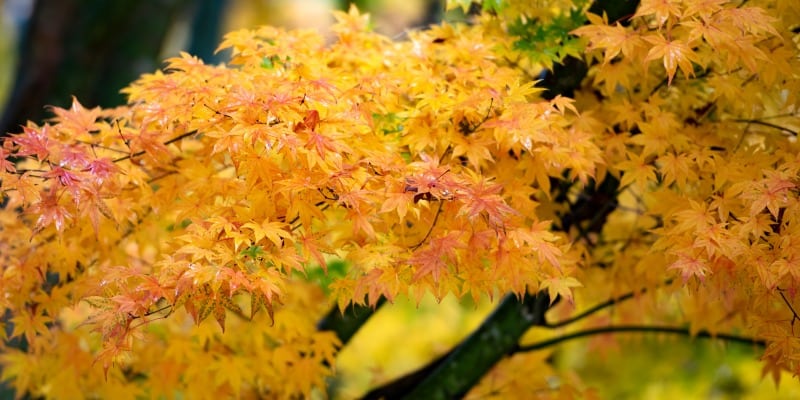Flower Glossary is reader-supported. When you buy through links on our site, we may earn an affiliate commission.
The beautiful Japanese maple is a deciduous shrub that is native to Japan, Korea, and other parts of Asia. With their striking colors and ability to grow in relatively small spaces, these make an ideal addition to your garden at home.
If you are unfamiliar with the Japanese maple, it can be quite a task to figure out the perfect growing conditions. Once you are able to cultivate this striking focal point in your own home garden, it will be well worth the research and hard work.

Table of Contents
Japanese Maple Overview
The Japanese maple is a typical feature in Asian landscaping and it comes in a variety of different colors and sizes. There are upright varieties that can grow up to 20 or 25 feet in height. Others are small enough to be used in Bonsai!
These slow-growing shrubs are primarily used as ornamental trees. The larger ones might turn into small shade trees over a very long period of time. For the most part, however, they are sought after for decorative purposes.
Species Names & Varieties of Japanese Maple
Different varieties of the Japanese maple come in different colors and sizes. Part of their appeal is the varying, striking hues of their leaves. For example, the classic Japanese maple features deep red, feathery leaves. This variety has graceful, drooping branches and is relatively small in size.
In contrast, we have the Coonara Pygmy. This dwarf Japanese maple has leaves that turn from a blush pink to a brilliant orange in the fall. It is small enough that you can grow it in containers or very small spaces.
The Autumn Moon is a variety that grows to around 25 feet tall. This Japanese maple variety has bright yellow leaves with just a tinge of pink around its edges. Like most other Japanese maples, however, this variety also turns gorgeous shades of red and orange in the fall.
The Higasayama is a favorite choice for growing using the Bonsai method. This species of Japanese maple features pink buds that open into green and fuchsia leaves. In the fall, the leaves change to more subdued shades of gold and yellow.

How To Grow & Care For Japanese Maple
The classic Japanese maple, the Coonara Pygmy, the Autumn Moon, and the Higasayama are only a handful of the thousand or so Japanese maples that exist. While these varieties have slightly different needs for them to reach their full potential, some of these needs are quite similar.
With that said, here are some tips to help grow and care for your Japanese maple.
When to plant
Let’s start at the very beginning. Where and how you plant your Japanese maple will set the tone for how successfully it grows. Correct planting could help your plant live more than twice as long as one that is planted incorrectly.
When is the most ideal time to plant your Japanese maple? If you plant in the fall, your tree will benefit from new root growth while the top parts of the plant remain dormant throughout the winter season (as long as the temperatures do not fall below freezing).
If you choose to plant in spring, just be sure that you do not disturb any plant parts that have begun to bud.
Where to plant
Finding the perfect spot for your Japanese maple is very important because this plays a heavy role in determining its survival.
You need to take into consideration the amount of sun exposure, wind exposure, and the amount of space available for your tree to grow. You must plant them in an area that is protected from harsh winds and spring frosts as this could damage your tree.
Planting in containers
You might decide to plant your Japanese maple in a container. This could be the ideal choice if you want it to be like a decorative Bonsai tree or if you want to be able to move your dwarf Japanese maple around the garden as the conditions change throughout the year.
Make sure that your container has proper drainage holes. This is very important because the Japanese maple does not fare well with its roots sitting in water. If the soil is too saturated with water, it could result in root rot.
You must also ensure that your container is not too big for your tree. The container should not be larger than twice the diameter of the tree’s root ball.
Soil
Even though Japanese maples are quite adaptive, they prefer soil that is moist, well-drained, and slightly acidic. It is also good if your soil contains organic matter, such as chicken manure (just be careful not to use too much as chicken manure can be quite alkaline).
You want to avoid planting your Japanese maple in clay as this does not drain very well. This will lead to root rot and disease. If you have to plant it in clay, then you could try to create a raised mound with good-quality potting soil (about 4 to 6 inches above your clay soil) and plant your Japanese maple in that.
Fertilizer
Fertilizers can be a great way to give your plants an advantage. However, in the case of Japanese maples, it is best to wait until their second growing season before you introduce fertilizers.
Use low-nitrogen fertilizers in the spring. Avoid using them in autumn because this could hamper their beautiful fall colors and their winter resilience.
Light
Japanese maples like filtered sun or part shade. If it is warm enough in your region, then they could thrive in full shade if need be. However, full shade could prevent your leaves from achieving the sought-after red hues in autumn.
On the other hand, you want to avoid heavy sunlight, especially in the afternoon. This could lead to sunburnt leaves. The main thing to keep in mind is that it is a delicate balancing act to find the right amount of shade for your tree.
Water
You need to water your Japanese maple well when you plant it. After it has been established, you don’t need to water it quite as frequently. Even though they can endure large dry spells at this point, try to keep them watered during a drought.
A handy tip is to hold back on watering your Japanese maple quite so often in late winter. This will encourage its leaves to turn deeper shades of red and orange.
Pruning
You do not need to prune your Japanese maples very often. You especially want to avoid pruning them in fall or winter because they will ooze sap. This could lead to the invasion of diseases and will weaken the tree.
Newly planted Japanese maples must only receive minimal pruning. Removing too much could negatively affect food production and could lead to poor root development.
The most ideal time to prune your Japanese maple is in summer. Don’t prune them in spring because this is when their leaves start to bud and expand. You can give your tree a touch up every year, but you only need to do thorough pruning every two or three years.
Japanese maples and Bonsai
As we mentioned before, Japanese maples are a great option for Bonsai. This is particularly in the case of varieties like the Coonara Pygmy. Bonsai is a traditional art form in Japan. By using certain cultivation techniques, you can artificially dwarf your tree to mimic a full-sized tree!
The Japanese maple is a great tree for Bonsai beginners because it is relatively easy to care for. Unlike ordinary Japanese maples care, you would need to prune a Bonsai tree more regularly to shape the tree and encourage branching.
Pests and diseases to look out for
Japanese maples are not susceptible to too many serious pests or diseases. Just make sure you keep an eye out for stem canker, root rot, leaf spots, verticillium wilt, fusarium, botrytis, and anthracnose.

Final Thoughts
The beauty of the Japanese maple varieties is unmatched. For the most part, they do not require too many special considerations for you to achieve the deep red colors of their fall leaves.
So, what are the main tips you should keep in mind? Remember to try and plant your Japanese maple in autumn to allow your tree to benefit from extra root growth. Choose a space in your garden that is protected from harsh winds and is partly shaded from the sun.
Your Japanese maple must be well-watered, but not sitting in drenched soil. If you plant your Japanese maple in a pot, make sure it allows for adequate drainage. Also, refrain from over-pruning your plant as you only need to do a thorough prune once every two or three years.
Whether you decide to use the Japanese maple for Bonsai, or simply want to keep it as a gorgeous focal point in your garden, this tree is a great choice. Your hard work will certainly pay off when you see the striking, impressive, and graceful leaves of the Japanese maple.